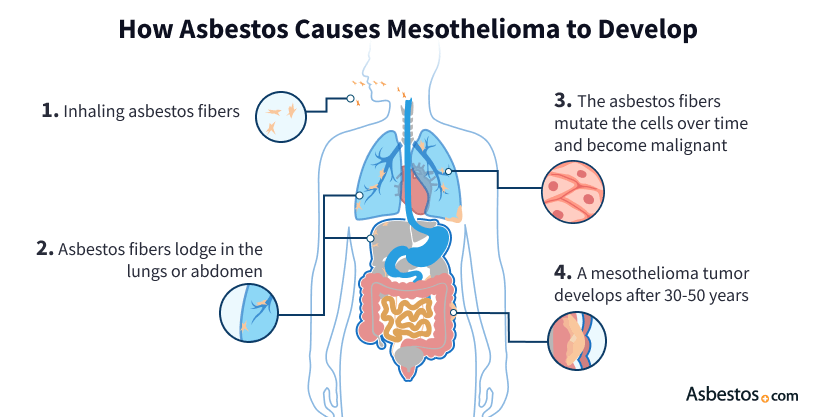Based on Your Reading:
Get Your Free Mesothelioma Guide

Find a Top Mesothelioma Doctor

Access Help Paying for Treatment

Asbestos exposure is the primary cause of mesothelioma. Occupational asbestos exposure is the No.1 cause of mesothelioma worldwide. Living with someone who works with asbestos can increase your chances of developing mesothelioma because fibers can be brought home on a worker’s skin and clothes.
Written by Karen Selby, RN • Edited By Walter Pacheco • Medically Reviewed By Dr. Jacques Fontaine
The Mesothelioma Center at Asbestos.com has provided patients and their loved ones the most updated and reliable information on mesothelioma and asbestos exposure since 2006.
Our team of Patient Advocates includes a medical doctor, a registered nurse, health services administrators, veterans, VA-accredited Claims Agents, an oncology patient navigator and hospice care expert. Their combined expertise means we help any mesothelioma patient or loved one through every step of their cancer journey.
More than 30 contributors, including mesothelioma doctors, survivors, health care professionals and other experts, have peer-reviewed our website and written unique research-driven articles to ensure you get the highest-quality medical and health information.
My family has only the highest compliment for the assistance and support that we received from The Mesothelioma Center. This is a staff of compassionate and knowledgeable individuals who respect what your family is experiencing and who go the extra mile to make an unfortunate diagnosis less stressful. Information and assistance were provided by The Mesothelioma Center at no cost to our family.LashawnMesothelioma patient’s daughter


Selby, K. (2024, April 2). Causes of Mesothelioma. Asbestos.com. Retrieved April 16, 2024, from https://www.asbestos.com/mesothelioma/causes/
Selby, Karen. "Causes of Mesothelioma." Asbestos.com, 2 Apr 2024, https://www.asbestos.com/mesothelioma/causes/.
Selby, Karen. "Causes of Mesothelioma." Asbestos.com. Last modified April 2, 2024. https://www.asbestos.com/mesothelioma/causes/.
Asbestos is the main cause of mesothelioma. The carcinogen accounts for more than 80% of mesothelioma cases. Most people diagnosed with mesothelioma experienced asbestos exposure from their jobs or military service.
My mesothelioma was caused by my father’s work clothes. He had been a lagger and worked with asbestos all through my childhood. He died of mesothelioma in 1989.
A smaller number of people develop mesothelioma as a result of secondhand contact. This is sometimes called take-home exposure because workers inadvertently brought the asbestos home on clothing or gear and exposed their families.
Get Your Free Mesothelioma Guide

Find a Top Mesothelioma Doctor

Access Help Paying for Treatment

Exposure to asbestos causes mesothelioma when a person inhales or ingests asbestos fibers. Once inside the body, these asbestos fibers get trapped in the mesothelium or very thin tissue that lines certain organs.
The fibers pierce this lining, causing inflammation and damage to the mesothelial cells. Over time, the chronic inflammation and the physical properties of asbestos fibers may lead to DNA damage. Ultimately this can cause the formation of mesothelioma tumors.

Asbestos fibers that embed in the outer lining of the lungs can cause pleural mesothelioma. When the fibers get stuck in the abdominal cavity, they may cause peritoneal mesothelioma. Asbestos fibers may also embed in the pericardium surrounding the heart or the membrane that covers the testes, though pericardial and testicular mesothelioma are both very rare.
Asbestos exposure is the biggest risk factor for a mesothelioma diagnosis. Occupational asbestos exposure ranks as the No. 1 risk factor for mesothelioma and other asbestos-related diseases, including asbestosis and pleural plaques.
The duration and intensity of asbestos exposure can affect the risk of developing mesothelioma. This is called a dose-response relationship. Any amount of asbestos exposure can potentially lead to mesothelioma, however.
Asbestos exposure is the top risk factor for mesothelioma and other factors can further increase your chance of developing the disease. A family history of mesothelioma may raise your risk. Overall health may also potentially put some people at increased risk of developing mesothelioma from asbestos exposure.
Age can also be a risk factor, but this is largely because it typically takes 20 to 60 years for mesothelioma to develop after exposure. However, mesothelioma can occur at any age. Rates of pleural mesothelioma are higher in men than women, but peritoneal mesothelioma affects men and women equally.
There are several types of asbestos exposure, including occupational exposure, military exposure, secondary exposure and environmental exposure. Occupational exposure is the most common type of exposure.
While many people know if they have been exposed to asbestos, others may not be aware of their exposure. Understanding the different sources of exposure is important for understanding your risk of developing mesothelioma. Asbestos exposure can come from unexpected places.
When mesothelioma patients are unsure of the source of their asbestos exposure, we talk about high-risk categories and sometimes a light goes off. If not, we talk about other exposure examples such as a recent case of a teacher who developed mesothelioma from asbestos in the school she taught in.
“In past years, most patients knew exactly how they were exposed to asbestos,” says Dr. Snehal Smart, a Patient Advocate at The Mesothelioma Center. “Recently, however, many patients aren’t as sure initially.”
Smart explains that, after learning more about the types of asbestos contact, some people recall experiencing secondhand exposure from living with someone who worked around asbestos. They may also realize they had talcum powder exposure.

The risk of developing asbestos-related diseases is highest for people who worked with the raw mineral, such as miners and workers in asbestos product manufacturing. Construction workers and firefighters today encounter asbestos while working in older buildings. Exposure can happen during renovation, demolition or disaster response.
Thousands of commercial, industrial and domestic products contained asbestos. Examples include drywall, insulation, pipes, glues, tiles, cement and talcum powder. Chrysotile asbestos was the most widely used in manufacturing, which is why it’s strongly associated with a risk of developing mesothelioma.
While products in homes contributed to asbestos contact, the greatest risk was to the people who manufactured asbestos products and those who used asbestos at work. Historically, men were more likely to have jobs with a greater risk of contact with asbestos. This has led to higher mesothelioma incidence rates in men than women.
Veterans also experience higher rates of mesothelioma because of asbestos exposure. Every branch of the military used asbestos extensively on bases and in vehicles, ships and planes.
Those who served in the Navy faced the highest risk of exposure. Asbestos helped reduce fires on ships and was used in protective gear such as respirators and heat-resistant gloves for operating gun turrets.
This is long overdue, and hopefully will lead to more acknowledgment of the hazards that veterans were exposed to during service, including asbestos exposure, Agent Orange and burn pits. The PACT Act will finally make it easier for veterans and families exposed to toxic chemicals at Camp Lejeune to access medical and financial assistance.
The Honoring Our PACT Act of 2022 expanded access to health care and disability benefits for veterans harmed when exposed to toxic substances such as contaminated water at Marine Corps Base Camp Lejeune. Advocates hope the PACT Act will streamline the VA process for veterans, increase the list of presumptive conditions included for benefits and expand health care eligibility.
David Cutts, a pleural mesothelioma survivor, served three years in the Marines. His service included active duty in Vietnam in the 1960s, and he served briefly on a Navy ship where asbestos was prevalent. “I’m an ex-Marine. My heart is in everything,” Cutts said. “I still want to do everything I once did. I’ve been fortunate. I’m an optimist.”
Secondary exposure happens when someone carries asbestos fibers on their skin, hair, clothing, footwear or tools, putting those around them at risk of exposure. People in occupations with high contact and proximity to asbestos were most at risk of bringing home asbestos on their bodies or gear.
Asbestos.com interviewed peritoneal mesothelioma survivor Tamron Little about her history of asbestos exposure. She believes she may have been exposed to asbestos-containing construction materials at a very young age.
The formerly widespread use of asbestos in all sorts of products inadvertently put many people at risk for primary and secondary exposure. For example, barbers and ceramics workers used talc contaminated with asbestos. Bringing these fibers home caused cancer in many of their family members.
Living near large asbestos deposits in hilly or mountainous regions puts residents at risk of environmental exposure. Minimal amounts of microscopic fibers can linger in the air in these regions. This is most dangerous near former asbestos mines and manufacturing plants.
In June 2009, the United States Environmental Protection Agency declared a public health emergency in Libby, Montana. The hazard arose from an asbestos-contaminated vermiculite mine in the town. The agency has since cleaned up the area, and Montana received $18.5 million from the former mine owner to settle claims for environmental damages. Despite the effort, thousands of residents have been diagnosed with asbestos-related diseases, including mesothelioma.
The risk associated with living near asbestos mines or facilities is relatively low when compared to occupational asbestos exposure. Research suggests coming into contact with asbestos this way may account for 3% of all mesothelioma cases and about 19% of cases in women.
Mesothelioma can cause various symptoms and complications. The type of complications can vary based on the location of mesothelioma tumors. Pleural mesothelioma is more likely to cause chest and respiratory complications, while peritoneal mesothelioma is more likely to cause abdominal symptoms.
Mesothelioma, like other cancers, affects the entire body. This can cause systemic symptoms like fever and weight loss. Mesothelioma can also metastasize and spread to other parts of the body. Peritoneal mesothelioma can spread to the lungs, for instance, and cause respiratory complications.

Because occupational asbestos exposure is the primary cause of mesothelioma, the best way to prevent mesothelioma is to follow workplace safety regulations and report potential hazards. Talk to your employer about asbestos risks and policies in place to mitigate those risks at your workplace.
The keys to preventing mesothelioma are understanding ways people come into contact with asbestos and taking precautions to avoid it. Avoiding asbestos products, natural asbestos deposits and talc-containing cosmetics will limit your contact and risk of developing mesothelioma.
Be cautious of older homes containing asbestos materials. Hire a professional asbestos abatement company that can test and remove asbestos materials. If you or a loved one has a history of asbestos exposure, talk to your doctor about cancer screenings. Early detection offers the best opportunity for effective mesothelioma treatment.
If you have a history of asbestos exposure, speak to your doctor about screenings for mesothelioma as soon as possible. If you develop respiratory, abdominal or other mesothelioma symptoms, see your doctor right away. Initial mesothelioma symptoms can include shortness of breath, chest pain or abdominal distress.
Your doctor will likely order imaging scans, blood tests and other tests based on your history of contact with asbestos and mesothelioma symptoms. A biopsy is needed to confirm a mesothelioma diagnosis.
General oncologists commonly misdiagnose this cancer as another disease or malignancy. Ask for a referral to a mesothelioma specialist. Patient Advocates can help connect you with a specialist for a diagnosis, second opinion and specialized treatment. Taking action quickly can help you obtain a diagnosis early in the course of the disease.
All types of asbestos exposure, including occupational, secondary and environmental, can cause mesothelioma. Every type of asbestos fiber, including chrysotile asbestos, can cause this cancer.
Men are more likely than women to receive a mesothelioma diagnosis. About 75% of people with mesothelioma are 65 years of age and older. This cancer is rare in people under age 45.
Symptoms of mesothelioma include chest pain, shortness of breath, stomach pain, abdominal swelling, fatigue and weight loss. A mesothelioma doctor is the best specialist to see for diagnosis and treatment.
Asbestos fibers turn healthy cells into cancer decades after exposure. The fibers initiate an inflammatory process that slowly causes genetic damage and eventually cancer 20 to 60 years later. Once tumors form, mesothelioma can quickly progress to stage 3 or 4 before causing symptoms.
No, smoking does not cause mesothelioma. The primary cause of mesothelioma is exposure to asbestos fibers. While smoking and tobacco use are linked to lung cancer and other malignancies, they are not associated with an increased risk of mesothelioma.
Answered By: Anna Nowak, internationally renowned asbestos researcher and mesothelioma advocate.
Researchers believe simian virus 40 can’t cause mesothelioma on its own, but the virus and asbestos may act as co-carcinogens. In some studies, researchers have found human mesothelial cells are susceptible to SV40. There are no reports of higher rates of cancer in those who received polio vaccines contaminated with SV40.
Your web browser is no longer supported by Microsoft. Update your browser for more security, speed and compatibility.
If you are looking for mesothelioma support, please contact our Patient Advocates at (855) 404-4592
